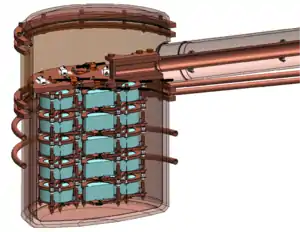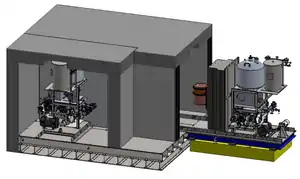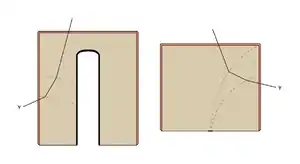MAJORANA
The MAJORANA project (styled Majorana) is an international effort to search for neutrinoless double-beta (0νββ) decay in 76Ge. The project builds upon the work of previous experiments, notably those performed by the Heidelberg–Moscow[1] and IGEX[2] collaborations, which used high-purity germanium (HPGe) detectors, to study neutrinoless double-beta decay.[3]


The first stage of the project is the Majorana Demonstrator, designed to demonstrate the technique and evaluate a ton-scale experiment.
Cryostats housing up to 40 kg of natural and enriched germanium detectors are being deployed in low-background vacuum cryostats, underground (1,480 m) at the Sanford Underground Laboratory in Lead, South Dakota. Following the Demonstrator, the collaboration intends to merge with the GERDA collaboration to build a much larger experiment called LEGEND.
Physics
The goal of the project is to search for 0νββ decay in 76Ge using HPGe detectors. Observation of 0νββ would establish that the neutrino is a Majorana particle and demonstrate violation of lepton number conservation, validating the seesaw mechanism as the explanation for the neutrino mass scale. It would also place constraints on the absolute neutrino mass.
The principal goal of the Majorana Demonstrator is to demonstrate the feasibility of achieving the background required in a ton-scale experiment. This corresponds to 4 counts/tonne/yr in a 4 keV window around the 0νββ Q value of 2039 keV, which scales to 1 count/ton/yr in a ton scale experiment. The experiment will use a mixture of detectors made with natural germanium and enriched germanium, allowing it to confirm or refute the controversial claim for 0νββ observation in 76Ge by Klapdor-Kleingrothaus et al.[4] If low enough electronic noise is achieved the Demonstrator may also make a search for WIMPs and axions.
Design

The Majorana Demonstrator will proceed in three phases. A prototype cryostat containing 3 strings of non-enriched germanium is in commissioning. Two low-background cryostats with enriched detectors are planned, with a total of 40 kg germanium.
Electroformed copper and lead bricks protect the cryostats. Polyethylene shields the setup and includes PMTs to act as a veto. Nitrogen flushing removes trace radon.
Point contact detectors
P-type point contact (PPC) germanium detectors are used.[5][6] This style of detector was chosen for many reasons, but chiefly because PPC detectors allow efficient discrimination of multiply scattering gamma backgrounds. This results from the weighting potential being strongly peaked close to the small electrode, meaning that as charge drifts towards the electrode there is a high probability of seeing distinct signals from each energy deposition, thus being able to reject events these signals. Other advantages include the low capacitance due to the small contacts, reducing electronic noise and thresholds; and shielding surface alpha decays by the thick outer n-type contact.
Status
At Dec 2014 the Majorana Demonstrator was under construction at the Sanford Underground Laboratory in Lead, South Dakota. The first module was expected in early 2015 with full operation expected in late 2015.[7]
MALBEK was operated 2011-12 at KURF (Kimballton Underground Research Facility) in Virginia as a WIMP detector to evaluate the broad energy (BEGe) PPCs. The background and behavior of the contacts was explored. No signal was seen, and the project could be a competitive search for low mass WIMPs.[8]
The collection of data started June 2015. The construction completed with final configuration taking data since spring 2017. First results were announced October 2017. Data collection continued as of 2018.[9]
References
- Klapdor-Kleingrothaus, H. V.; et al. (2001). "Latest results from the Heidelberg–Moscow double beta decay experiment". European Physical Journal A. 12 (2): 147–154. arXiv:hep-ph/0103062. Bibcode:2001EPJA...12..147K. CiteSeerX 10.1.1.341.9296. doi:10.1007/s100500170022.
- Aalseth, C. E.; et al. (2000). "Recent Results of the IGEX 76Ge Double-Beta Decay Experiment". Physics of Atomic Nuclei. 63 (7): 1225–1228. Bibcode:2000PAN....63.1225A. doi:10.1134/1.855774.
- Taylor, Dan (1 April 2018). "Massive discovery about the universe shocks scientists". MorningTicker.com. Retrieved 1 April 2018.
- Klapdor-Kleingrothaus H.V.; et al. (2004). "Search for neutrinoless double beta decay with enriched 76Ge in Gran Sasso 1990-2003". Physics Letters B. 586 (3–4): 198–212. arXiv:hep-ph/0404088. Bibcode:2004PhLB..586..198K. doi:10.1016/j.physletb.2004.02.025.
- Luke P.; et al. (1989). "Low capacitance large volume shaped-field germanium detector". IEEE Transactions on Nuclear Science. 36 (1): 926–930. Bibcode:1989ITNS...36..926L. doi:10.1109/23.34577.
- Barbeau P.; et al. (2007). "Large-mass ultra low noise germanium detectors: performance and applications in neutrino and astroparticle physics". Journal of Cosmology and Astroparticle Physics. 2007 (9): 009. arXiv:nucl-ex/0701012. Bibcode:2007JCAP...09..009B. doi:10.1088/1475-7516/2007/09/009.
- Xu, W.; et al. (13 Jan 2015). "The Majorana Demonstrator: A Search for Neutrinoless Double-beta Decay of 76Ge". Journal of Physics: Conference Series. 606 (606): 012004. arXiv:1501.03089. Bibcode:2015JPhCS.606a2004X. doi:10.1088/1742-6596/606/1/012004.
- "A Dark Matter Search with MALBEK". 13th International Conference on Topics in Astroparticle and Underground Physics. 8 Jul 2014.
- Guiseppe, Vincente (2018). "New Results from the Majorana Demonstrator Experiment". doi:10.5281/zenodo.1286900. Cite journal requires
|journal=(help)
Bibliography
- The MAJORANA Collaboration (2008). "The MAJORANA Neutrinoless Double-Beta Decay Program - An R&D plan to establish the feasibility of a 1-ton scale experiment". Cite journal requires
|journal=(help) - Phillips II, D. G.; et al. (2011). "The MAJORANA experiment: An ultra-low background search for neutrinoless double-beta decay". Journal of Physics: Conference Series. 381 (381): 012044. arXiv:1111.5578. Bibcode:2012JPhCS.381a2044P. doi:10.1088/1742-6596/381/1/012044.
